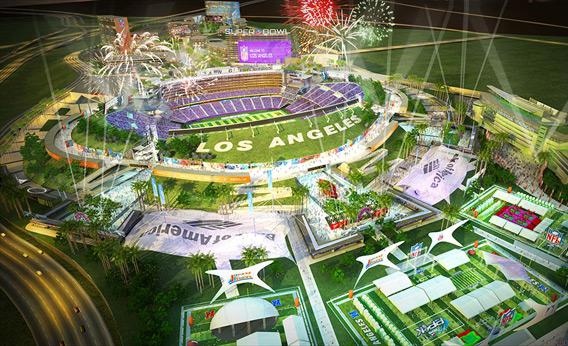Oh, the Jags-to-Los Angeles speculation. For ages now, a hypothetical Los Angeles NFL team—the Jaguars, the Bucs, the Unicorns—has been just over the horizon, a mythic solution to all of the league’s problems. When a franchise can’t get its stadium plans together (like the Vikings), or when a dwindling fan base or a change in ownership threatens a team’s staying power (like the Jaguars), L.A. is invariably the go-to solution—the Promised Land, even. The comical underlying fiction here is that because each franchise that cycles into its own troubles looks West for its salvation, the NFL’s return to Los Angeles will keep any more teams anywhere from cycling into trouble again.
But now Los Angeles is threatening to attach an actual building to this hypothetical future. By 2016, if things go according to plan, the city could have a shining yet solid new stadium, awaiting the arrival of whichever league castoff is threatening to make the move that year.
In August, the Los Angeles City Council approved a $1.5 billion deal to develop a stadium downtown. This stadium, Farmers Field—the naming rights have already been purchased by Farmers Insurance Group—would be adjacent to the Staples Center and the Los Angeles Convention Center.
The council’s approval was a boon for the Anschutz Entertainment Group, which had submitted proposals as early as December 2010. AEG has a leg up on Ed Roski, the real estate developer who had proposed the design you see below back in 2008. In his original plan, Roski promised to “buy a full or majority share of a team, relocate it to Los Angeles and privately finance a stadium” in the City of Industry, about 20 miles east of L.A.
AEG’s plan seems more feasible now—especially financially, as Roski’s plan would make any relocated team the majority owner—but I like calling up the City of Industry models when I’m thinking about the eternal promise of the L.A. football team. The rendering you see below is Roski’s vision for what his future L.A. football stadium will look like the day that it hosts the Super Bowl (let’s call it Super Bowl ∞). It’s going to be epic as long as the Coca-Cola blimp manages to avoid the fireworks showering the field.
This place looks more fun than Disney.
But let’s not forget the particular location we’re dealing with here. The first professional football team out of L.A., in 1926, didn’t even play there. The Los Angeles Buccaneers were a road team made up of University of California and University of Southern California alumni and were based out of Chicago. A truly L.A.-based team wasn’t really a viable option. The Coliseum had an “unofficial ban” on pro teams playing in the stadium. As Michael MacCambridge explains it in his book America’s Game, the Coliseum Commission—which consisted mostly of USC and UCLA alums—felt a duty to maintain “college football’s primacy on the West Coast.” What’s more, it was kind of difficult and time-consuming to navigate the Rockies back then.

Photo courtesy of Los Angeles Football Stadium.
So the displaced L.A. Bucs played just a single season, traveling around the Midwest for games, and finished 6-3-1. (Another L.A. team, the Wildcats, was also based in Chicago.) It wasn’t until the 1930s, when the NFL briefly considered admitting the Los Angeles Bulldogs into the league, that the City of Angels had a pro team based in Los Angeles. The Bulldogs played in the second generation of the American Football League in 1937, and then played for about a decade in the Pacific Coast Professional Football League. The Cleveland Rams arrived in 1946, and the Oakland Raiders showed up in 1982. Both skipped town in 1995—the Rams for the considerably less enchanted St. Louis, the Raiders for a return to Oakland.
Somehow Los Angeles’ failure became a virtue: By losing two NFL teams at once, the city instantly became the nation’s largest market without an NFL team. So today, the idea of a team’s relocation to L.A. represents untapped potential, rather than tapped-out potential. Even Entourage, a show that has never bothered to invoke anything close to reality, floated a storyline about bringing an NFL team to Los Angeles a few seasons back—the L.A. Golds. But the reality of any kind of relocation is that it always screws the former city’s fan base and leaves another stadium—no longer shiny and fireworks-y—standing empty. (And the presumption that “if you build it, they will come” has failed plenty of times in pro sports. Look no further than Tropicana Field.)
Part of the theory that’s grown over the years is that the league and its owners like having Los Angeles around to force other cities to bid against it. Baltimore, after losing the Colts, used to serve a similar function—so well, in fact, that the league snubbed its expansion bid in 1993 to award a franchise to the less promising Jacksonville. Oddly enough, Baltimore finally succeeded in getting an NFL team as soon as the Los Angeles NFL market opened up.
Even in the past year, as Minnesota struggles to build a new stadium, L.A.’s been considered a constant ultimatum on the horizon—even though no one with the Vikings has directly endorsed a move. With the sale of the Jaguars, Jacksonville’s next on the block. I’ll believe it when I see Super Bowl ∞.